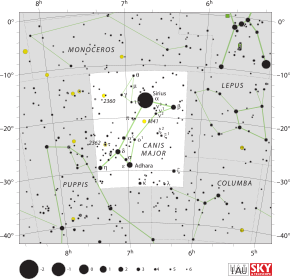
Back Groot Hond (sterrebeeld) Afrikaans الكلب الأكبر (كوكبة) Arabic كانيس مايور ARZ Canis Maior AST Böyük Köpək (bürc) Azerbaijani Ҙур эт (йондоҙлоҡ) Bashkir Вялікі Пёс (сузор’е) Byelorussian Вялікі Пёс BE-X-OLD Голямо куче Bulgarian যুগল (তারামণ্ডল) Bengali/Bangla
| Constellation | |
 | |
| Abbreviation | CMa |
|---|---|
| Genitive | Canis Majoris |
| Pronunciation | /ˌkeɪnɪs ˈmeɪdʒər/ KAY-niss MAY-jər, genitive /ˌkeɪnɪs məˈdʒɔːrɪs/ KAY-niss mə-JOR-iss |
| Symbolism | the greater dog |
| Right ascension | 06h 12.5m to 07h 27.5m [1] |
| Declination | −11.03° to −33.25°[1] |
| Area | 380 sq. deg. (43rd) |
| Main stars | 8 |
| Bayer/Flamsteed stars | 32 |
| Stars with planets | 7 |
| Stars brighter than 3.00m | 5 |
| Stars within 10.00 pc (32.62 ly) | 1 |
| Brightest star | Sirius (α CMa) (−1.46m) |
| Messier objects | 1 |
| Meteor showers | 0 |
| Bordering constellations | |
| Visible at latitudes between +60° and −90°. Best visible at 21:00 (9 p.m.) during the month of February. | |
Canis Major is a constellation in the southern celestial hemisphere. In the second century, it was included in Ptolemy's 48 constellations, and is counted among the 88 modern constellations. Its name is Latin for "greater dog" in contrast to Canis Minor, the "lesser dog"; both figures are commonly represented as following the constellation of Orion the hunter through the sky. The Milky Way passes through Canis Major and several open clusters lie within its borders, most notably M41.
Canis Major contains Sirius, the brightest star in the night sky, known as the "dog star". It is bright because of its proximity to the Solar System and its intrinsic brightness. In contrast, the other bright stars of the constellation are stars of great distance and high luminosity. At magnitude 1.5, Epsilon Canis Majoris (Adhara) is the second-brightest star of the constellation and the brightest source of extreme ultraviolet radiation in the night sky. Next in brightness are the yellow-white supergiant Delta (Wezen) at 1.8, the blue-white giant Beta (Mirzam) at 2.0, blue-white supergiants Eta (Aludra) at 2.4 and Omicron2 at 3.0, and white spectroscopic binary Zeta (Furud), also at 3.0. The red hypergiant VY CMa is one of the largest stars known, while the neutron star RX J0720.4-3125 has a radius of a mere 5 km.